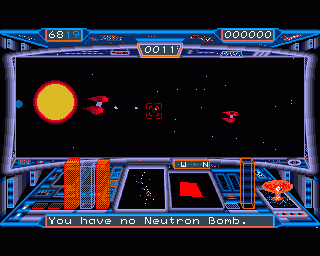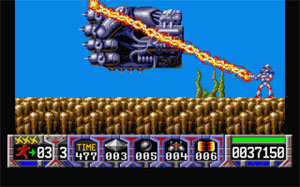Set someone free in a game world and they will do their best to test the limits, whether it’s finding the altitude ceiling in a flight simulator or walking up to the horizon in a game like Hunter (Amiga/Atari ST).
Often game designers will deal with this kind of behaviour by simply telling the player they will die if they stray from the path. Other times games will use story elements to account for restricted movement in the world. Mario Bros. played with your expectations by having hidden items and the ability to head-butt your way out of the frame in Bowser’s castle.
 Then there was Starglider 2 for the Amiga. I bought the game second-hand from a market stall in Dartmouth, Devon, where I grew up. You could point your spaceship at the sky in Starglider 2 and leave the planet’s atmosphere. The sky changed colour as you ascended and then went black as you entered space. You could travel through space to different planets. All this without a loading screen. I spent many hours exploring the Starglider universe. To be honest, I didn’t pay much attention to the game’s plot. I was happy exploring the endless tunnel systems beneath the planets’ surfaces, collecting alien items, and blowing up petrified trees.
Then there was Starglider 2 for the Amiga. I bought the game second-hand from a market stall in Dartmouth, Devon, where I grew up. You could point your spaceship at the sky in Starglider 2 and leave the planet’s atmosphere. The sky changed colour as you ascended and then went black as you entered space. You could travel through space to different planets. All this without a loading screen. I spent many hours exploring the Starglider universe. To be honest, I didn’t pay much attention to the game’s plot. I was happy exploring the endless tunnel systems beneath the planets’ surfaces, collecting alien items, and blowing up petrified trees.

 Here’s a new design for you lovely programmers out there.
Here’s a new design for you lovely programmers out there.
 I’ve never forgotten the music of Turrican and Turrican 2. They were two of the only games I completed on my Amiga 500. Playing Turrican again recently on an emulator, muscle memory took over, and I flew through the first level, collecting hidden power ups and timing jumps just right. This had nothing to do with skill. The truth is I must have played that level a hundred times as a ten year old, played till my eyes hurt, not because it was hard, but because I was happy just to explore the world and allow the strange, melancholy music of Turrican to take over.
I’ve never forgotten the music of Turrican and Turrican 2. They were two of the only games I completed on my Amiga 500. Playing Turrican again recently on an emulator, muscle memory took over, and I flew through the first level, collecting hidden power ups and timing jumps just right. This had nothing to do with skill. The truth is I must have played that level a hundred times as a ten year old, played till my eyes hurt, not because it was hard, but because I was happy just to explore the world and allow the strange, melancholy music of Turrican to take over. There are many dedicated modders out there. We’ve seen some pretty cool stuff ranging from lighting systems to skins and many software mods. But this, for me, has to be one of the best.
There are many dedicated modders out there. We’ve seen some pretty cool stuff ranging from lighting systems to skins and many software mods. But this, for me, has to be one of the best.
 With a hint of irony, I was downloading Sonic 3 the other day via the Wii’s Virtual Console. Bearing in mind the only classic Sonic game I’d played was the original, plus the mediocre 3D efforts on Dreamcast and GameCube, I was pretty excited.
With a hint of irony, I was downloading Sonic 3 the other day via the Wii’s Virtual Console. Bearing in mind the only classic Sonic game I’d played was the original, plus the mediocre 3D efforts on Dreamcast and GameCube, I was pretty excited.

 Last month I re-gained the use of my Dreamcast after managing to get hold of the AV cable I’d lost. I even picked up two controllers for a quid each – this means Fur Fighters is a must buy now. Ever since my consoles reincarnation I’ve been playing Crazy Taxi and Chu Chu rocket endlessly. But the one game I’ve not been able to keep away from is Virtua Tennis. I’ve ‘virtually’ completed the game now so it seems appropriate to post a retro review.
Last month I re-gained the use of my Dreamcast after managing to get hold of the AV cable I’d lost. I even picked up two controllers for a quid each – this means Fur Fighters is a must buy now. Ever since my consoles reincarnation I’ve been playing Crazy Taxi and Chu Chu rocket endlessly. But the one game I’ve not been able to keep away from is Virtua Tennis. I’ve ‘virtually’ completed the game now so it seems appropriate to post a retro review.
 Having literally just finished playing through Monkey Island 2 once again, I was absolutely gobsmacked to see this fantastic offering on eBay.
Having literally just finished playing through Monkey Island 2 once again, I was absolutely gobsmacked to see this fantastic offering on eBay.